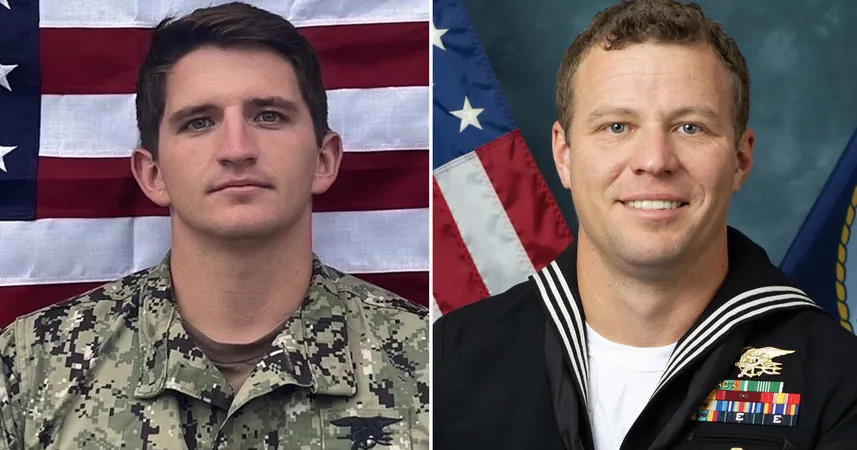
Tragic Loss: Navy SEALs' Drownings in Somalia Were Preventable, Says Navy Investigation
2024-10-11
Author: Kai
Introduction
Washington — A devastating incident last January off the coast of Somalia claimed the lives of two brave Navy SEALs, Special Warfare Officer Christopher Chambers, 37, and Special Warfare Officer First Class Nathan Gage Ingram, 27. A recently released report from the U.S. Navy's eight-month investigation has concluded that their tragic deaths were indeed preventable, revealing a series of procedural flaws and equipment failures leading to the incident.
Incident Overview
On the morning of January 11, Chambers fell overboard while attempting to board a Houthi vessel suspected of smuggling Iranian weapons to Yemen. His teammate, Ingram, immediately leaped into the water in a desperate attempt to rescue him. Tragically, both men sank beneath the waves within a mere 47 seconds.
Investigation Findings
The Navy's investigation highlighted numerous shortcomings, including inadequate training and equipment misuse, which contributed to their inability to stay afloat. The report explained that both SEALs were significantly weighed down by their gear—nearly 50 pounds for Chambers and an additional 30 pounds for Ingram, who was carrying a radio in a backpack. These burdens impeded their flotation devices, known as Tactical Flotation Support Systems (TFSS), from functioning properly, leaving them unable to remain at the surface.
To make matters worse, the conditions during the operation were challenging but not deemed responsible for the accident. “The environmental conditions were near or at the threshold for the mission,” stated Rear Admiral Michael Devore, although he emphasized that they were not causal to this terrible mishap.
Witness Accounts
Witness accounts and video footage from a U.S. helicopter that hovered 200 feet overhead indicated that both men intermittently surfaced in the turbulent waters, but their survival chances diminished rapidly. A comprehensive 10-day search operation yielded little, aside from finding one flotation device in the depths of the sea.
Critical Issues Identified
This investigation shines a light on several critical issues related to the incident: - Failure to recognize and mitigate risks associated with buoyancy support. - Lack of buoyancy tests once deployed in the field. - Insufficient training on the proper use of the Tactical Flotation Support System. - Absence of coherent guidance on buoyancy requirements. - Maintenance protocols for TFSS that failed to meet Navy standards.
Aftermath and Recommendations
Despite the harrowing circumstances, the SEAL team successfully located weapons aboard the Houthi vessel during their operation, thwarting a significant threat. U.S. Navy Commander Timothy Hawkins extended heartfelt condolences to the families of Chambers and Ingram, stating, "We remember them as heroes who died defending our nation." In light of the investigation’s findings, several recommendations were made, including improving training protocols, refining risk assessments, enforcing buoyancy guidelines, and implementing rigorous pre-mission buddy checks to ensure the safety of personnel during such perilous situations.
Conclusion
General Michael Kurilla, commander of U.S. military's Central Command, remarked, "This incident, marked by systemic issues, was preventable." The report underscores the critical nature of proper protocols and equipment maintenance in safeguarding the lives of those who serve our nation. As investigations continue and families mourn their loss, the Navy seeks to ensure that no such tragedy occurs again in the future. The lessons learned from this heartbreaking event will hopefully pave the way for enhanced safety measures for our elite forces.



 Brasil (PT)
Brasil (PT)
 Canada (EN)
Canada (EN)
 Chile (ES)
Chile (ES)
 España (ES)
España (ES)
 France (FR)
France (FR)
 Hong Kong (EN)
Hong Kong (EN)
 Italia (IT)
Italia (IT)
 日本 (JA)
日本 (JA)
 Magyarország (HU)
Magyarország (HU)
 Norge (NO)
Norge (NO)
 Polska (PL)
Polska (PL)
 Schweiz (DE)
Schweiz (DE)
 Singapore (EN)
Singapore (EN)
 Sverige (SV)
Sverige (SV)
 Suomi (FI)
Suomi (FI)
 Türkiye (TR)
Türkiye (TR)